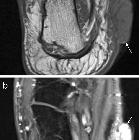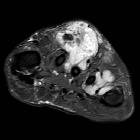Kaposi sarcoma




























Kaposi sarcoma is a low-to-intermediate grade mesenchymal tumor that involves the lymphovascular system. The tumor can involve the pulmonary, gastrointestinal, cutaneous and musculoskeletal systems.
Pathology
There are four recognized variants :
- classic (chronic): multiple distal lower extremity predominant purple skin plaques and rarely involve visceral organs
- endemic (lymphadenopathic): common in equatorial Africa
- iatrogenic (organ transplant-related)
- AIDS-related (epidemic): usually requires the CD4 count to drop <200 cells/mm; may develop in up to 35% of patients with AIDS and when developed it is considered an AIDS-defining illness
The latter two variants are much more common.
Etiology
An etiological association with human herpes virus type 8 (HHV8) has been postulated. The AIDS-related and post-transplant variants are also associated with immunosuppressive states.
Histology
Histologically can comprise of sheets of plump spindle-shaped cells surrounding and lining slit-like vascular spaces.
Associations
- lymphoproliferative disorders (particularly with the classic form)
Radiographic features
There is a wide spectrum of imaging findings depending on which organ is involved. However, most features are non-specific but may assist in diagnosis if relevant clinical risk factors (e.g. background AIDS history) are evident. In 30% of cases, there is no concurrent cutaneous involvement .
Plain radiograph
The following features may be seen on chest radiographs:
- parenchymal nodular or reticular opacities with a predilection towards perihilar mid to lower zones; has two major patterns
- linear interstitial nodules
- fluffy ill-defined nodules
- pleural effusion(s)
- mediastinal and/or hilar lymphadenopathy
CT
On HRCT of the chest:
- ill-defined (flame-shaped) nodular opacities with usually bilateral and roughly symmetrical perilymphatic and peribronchovascular distribution (1-2 mm)
- may have surrounding patchy ground glass changes
- interlobular septal thickening
- lymphadenopathy (may be present in up to 50%)
- lymphadenopathy is typically of high attenuation
On liver CT:
- ill-defined multifocal peripheral portal nodules with variable attenuation (commonest hepatic neoplasm in AIDS patients)
Nuclear medicine
Scintigraphy may be useful if concurrent opportunistic infection or lymphoma is suspected:
- thallium-201: usually positive in both lymphoma and Kaposi sarcoma
- gallium-67: usually negative in Kaposi sarcoma but positive in lymphoma and infection
History and etymology
This condition was first described by Moritz Kaposi (1837-1902), an Austro-Hungarian dermatologist, in 1872.
Differential diagnosis
For thoracic involvement consider:
- lymphoma (AIDS-related lymphoma: ARL): appear more well defined
- atypical pneumonia (e.g. Pneumocystis jiroveci)
- fungal (e.g. angioinvasive aspergillosis) or mycobacterial infection
- bacillary angiomatosis: also has skeletal lesions
Siehe auch:
- Pleuraerguss
- Milchglasverschattungen
- verdickte interlobuläre Septen
- bacillary angiomatosis
- AIDS defining illnesses
- Pneumocystis jiroveci
- Kaposisarkom der Lunge
- high attenuation
und weiter:
- WHO-Klassifikation der Tumoren des zentralen Nervensystems
- immune reconstitution inflammatory syndrome
- Pneumocystis jiroveci Pneumonie
- Vergrößerung der zervikalen Lymphknoten
- WHO Klassifikation der Weichteiltumoren
- bilaterale axilläre Lymphadenopathie
- AIDS defining illness
- hyperdenser Lymphknoten
- Weichteilsarkom
- Angiosarkom des Herzens
- Skrofeln
- musculoskeletal manifestations of AIDS
- AIDS defining malignancies
- pulmonary manifestations of AIDS
- cardiovascular manifestations of AIDS
- hypervaskularisierte Lymphknoten
- gastrointestinal manifestations of AIDS
- bronchovascular spread (mnemonic)
- malignant vascular tumours
- osseous Kaposi's sarcoma
- non-AIDS associated Kaposi sarcoma
- Kaposi’s sarcoma of the foot
- Tumoren des rechten Vorhofs
- thorakales Kaposisarkom

 Assoziationen und Differentialdiagnosen zu Kaposisarkom:
Assoziationen und Differentialdiagnosen zu Kaposisarkom:


